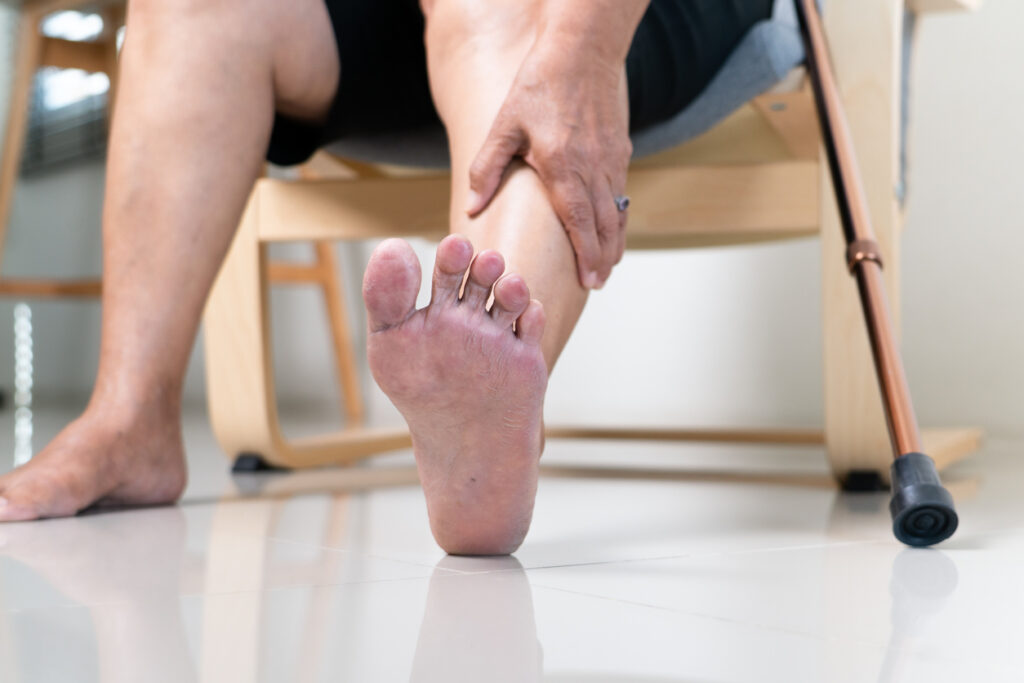All-cause mortality is 50% more likely during this common diabetes complication
SOMERVILLE, Mass., January 18, 2022 — Podimetrics, a virtual care support company dedicated to preventing costly and deadly diabetic amputations, today announced results from its latest research, which compared the health of individuals during and after periods of diabetic foot ulceration — open sores or wounds on the foot, which commonly occur among those with diabetes and are the leading cause of diabetic amputations. The research found that during a diabetic foot ulcer episode, individuals are 50 percent more likely to die and nearly three times more likely to be hospitalized. The peer-reviewed research was published in Diabetes Research and Clinical Practice, the journal of the International Diabetes Federation.
Diabetic Foot Ulcer Episode: A Closer Look
“Patients who experience a diabetic foot ulcer tend to be medically complex with multiple other chronic health conditions, putting them at higher risk for hospitalization and death, and they’re often among the costliest patients in our health care system,” said Dr. David G. Armstrong, Professor of Surgery at USC’s Keck School of Medicine and co-author of the study. “Diabetic foot complications should be viewed not as an innocent bystander, but instead as an accomplice driving and exacerbating additional chronic complications not commonly thought to be associated with diabetic foot ulcers. This change in perspective requires us to take a comprehensive look at the patient beyond their diabetic foot in order to identify other complex chronic conditions that might affect them. In doing so, we can fully grasp the significant economic and health burden of these episodes.”
The research found that diabetic foot ulcer episodes-of-care were broadly associated with inpatient admissions for conditions not commonly thought to be associated with diabetic foot complications. During diabetic foot ulcer episodes-of-care, individuals are 30 times more likely to have a lower limb amputation, eight times more likely to be hospitalized for peripheral vascular disorders, and about two times more likely to be hospitalized for renal failure, congestive heart failure (CHF), pulmonary edema, chronic obstructive pulmonary disease (COPD), or a heart attack.
“Every four minutes in the United States, someone has a limb amputated due to diabetes. And while most of these cases are avoidable, the associated health implications extend beyond the limb,” said Dr. Jon Bloom, the chief executive officer and co-founder of Podimetrics, who co-authored the study. “Contrary to the name, diabetic foot ulcers are not processes limited to the foot. They represent a massive inflammatory cascade, likely affecting every organ system in the body to varying degrees. By focusing on preventing the wounds that lead to amputations, we have the opportunity to improve patient outcomes and dramatically decrease downstream hospitalizations. This is especially critical while we aim to decrease the burden on struggling health care systems managing Omicron.”
For this population-based study, the researchers used inpatient institutional, outpatient institutional, and provider fee-for-service claims data from the Medicare Limited Data Set between 2013 and 2019 to compare rates of mortality and hospitalization outcomes during and after diabetic foot ulceration episodes among the same beneficiaries. The researchers analyzed claims from nearly 4 million unique Medicare beneficiaries.
In addition to preventing comorbidities, early detection of diabetic foot complications is critical given the scale and costs directly associated with these problems.
“Preventing diabetic foot complications is too often a blindspot in diabetes care programming, resulting in significant costs for patients and health plans. More than one million diabetic foot ulcers are diagnosed annually, representing one-third of the $327 billion spent on diabetes each year in the U.S.; these can lead to debilitating amputations, each of which can cost more than $100,000,” said Simon Salgado, Podimetrics’ vice president of enterprise health services and co-author of the study. “This new research strongly illustrates the correlation between diabetic foot ulcer episodes-of-care and other serious health events that we already know drive exorbitant costs.”
About Podimetrics
Podimetrics is a virtual care support company dedicated to preventing costly and deadly diabetic amputations. We provide high-risk patients with our FDA-cleared SmartMat through partnerships with payers and at-risk providers, including the Veterans Health Administration. After placing their feet on the mat for just 20 seconds a day, patients’ data are automatically sent to our care management team, which helps address any concerning findings. By combining cutting-edge technology with best-in-class care management, Podimetrics earns high engagement rates from patients, and allows clinicians to achieve unparalleled outcomes saving limbs, lives, and money, keeping vulnerable populations healthy at home. The company has received numerous accolades, including having been named the winner of UCSF Health Awards in the Consumer Prevention category (2021) and the winner of the Massachusetts Innovation Network’s Robert J. Crowley Spirit of Innovation Eddie Award (2021). For more information, go to www.podimetrics.com or follow us on Twitter @podimetrics.


